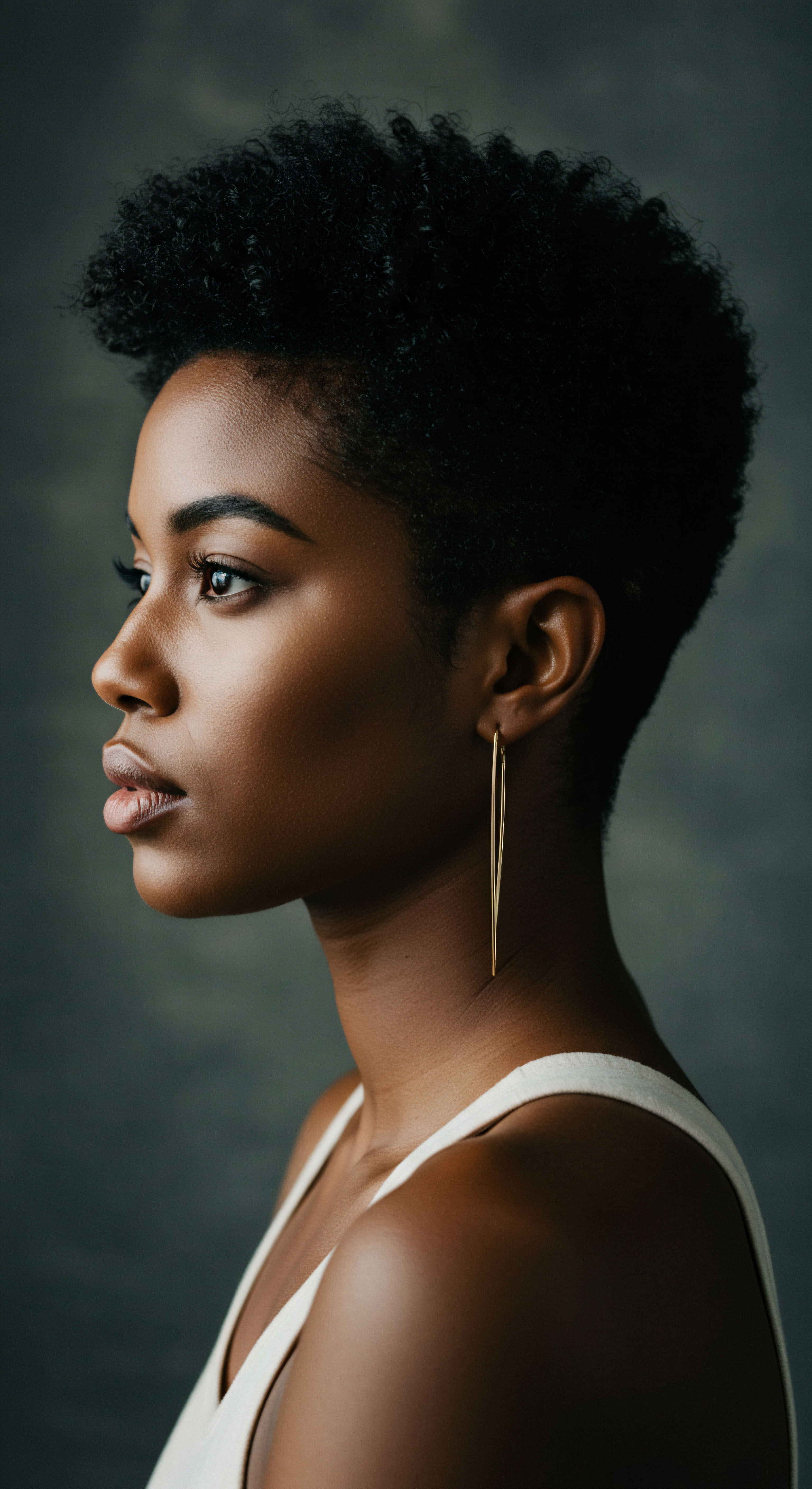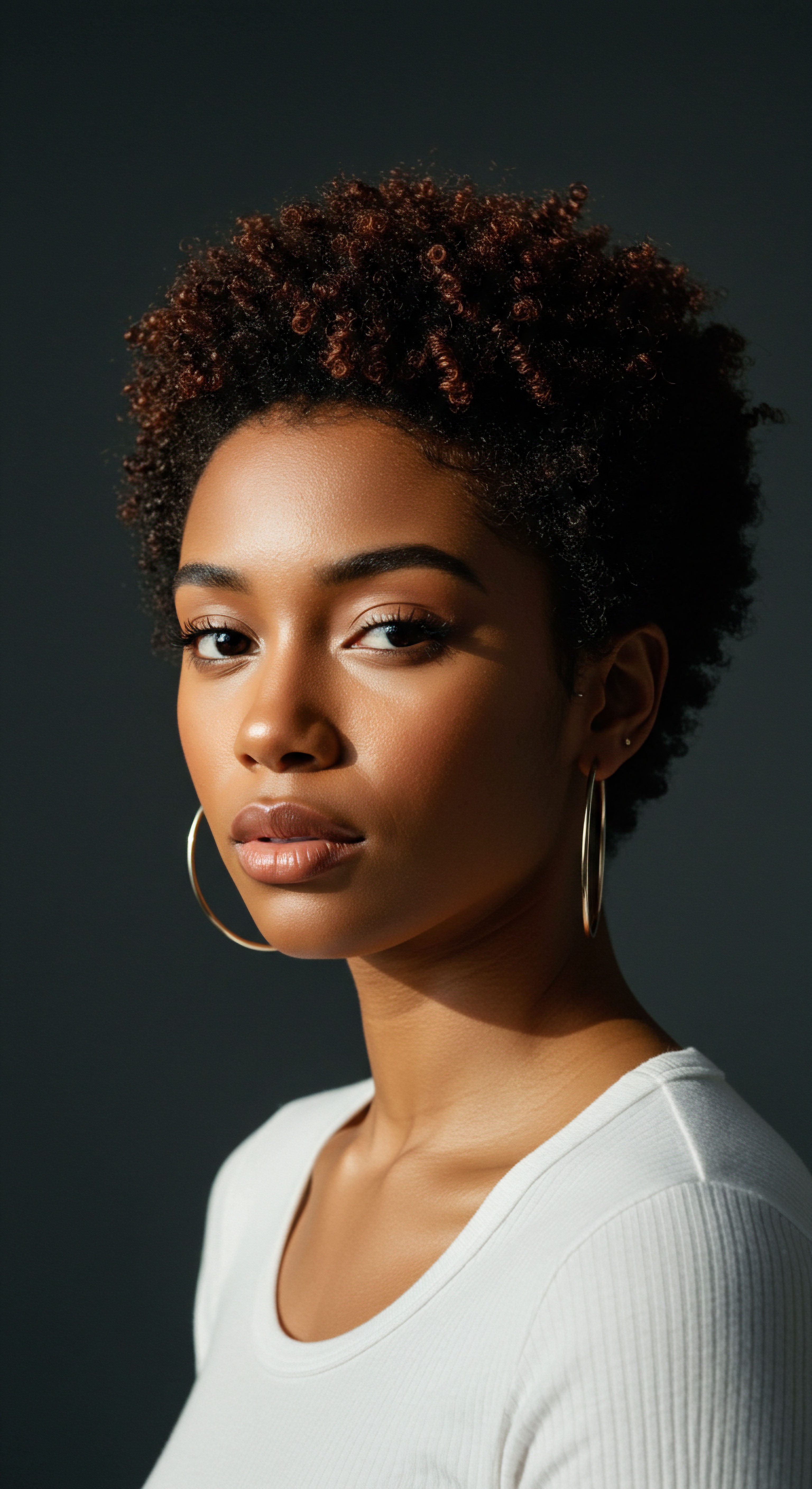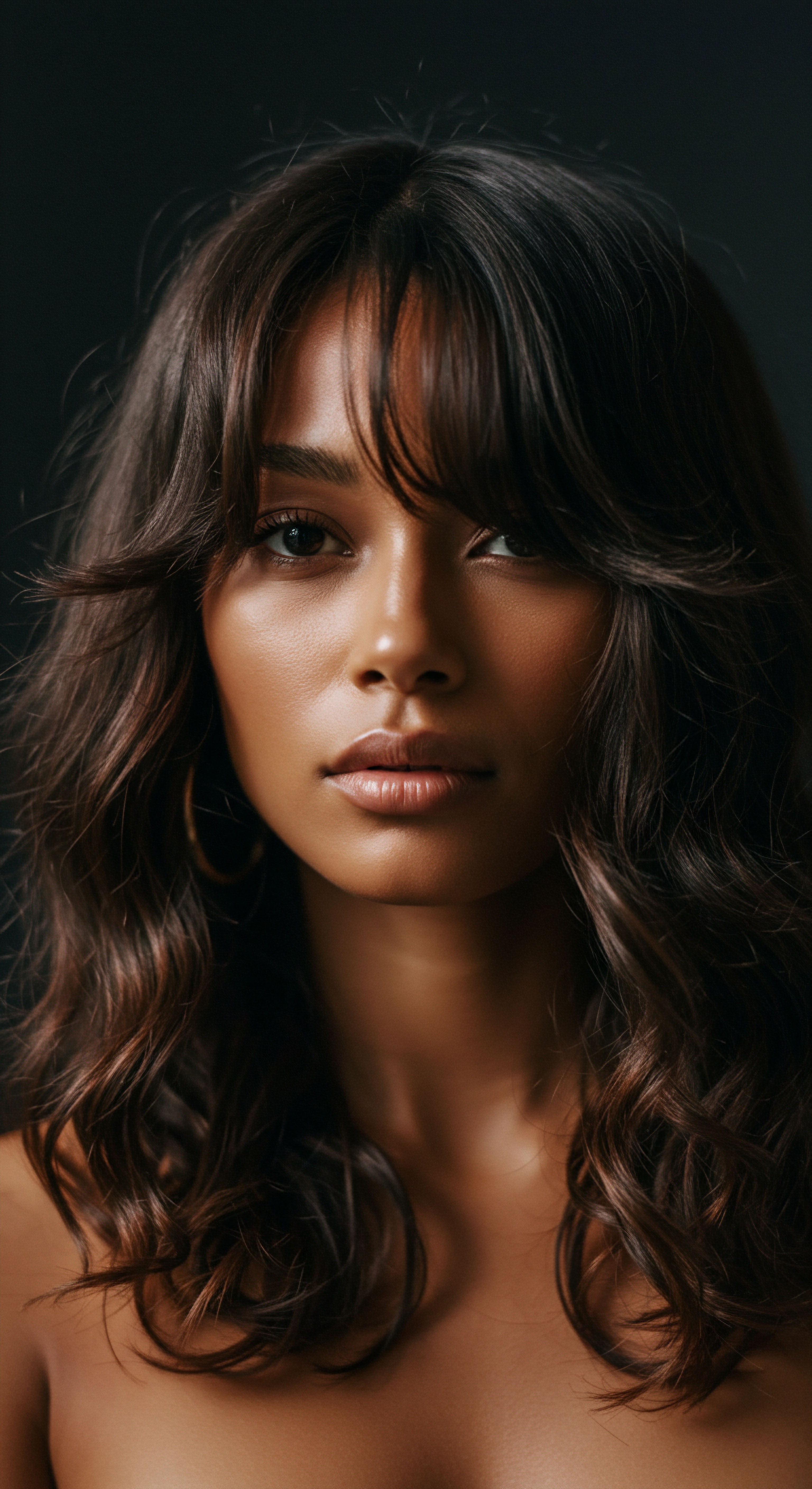
Roots
Consider for a moment the very essence of hair, particularly textured hair, with its unique coils, curls, and waves. This magnificent natural adornment, so often a focal point of personal and cultural identity, has long been a canvas for human expression. From ancient civilizations to present-day practices, the desire to alter or enhance hair’s natural hue has persisted, giving rise to a fascinating lineage of plant-based colorants.
This exploration uncovers the deep connection between historical plant dyes and textured hair, a relationship rooted in ancient wisdom and a profound understanding of nature’s offerings. We delve into how these botanical wonders interacted with the distinct characteristics of textured hair, celebrating a heritage of beauty that transcends mere aesthetics.

What Is Textured Hair’s Distinctive Structure?
To truly appreciate the interaction of historical plant dyes with textured hair, a grasp of its unique architecture is essential. Unlike straight strands, which typically possess a round cross-section, textured hair often exhibits an oval or even flat cross-section. This shape, combined with the way keratin proteins are distributed and bonded, causes the hair shaft to curve, creating the characteristic spirals and zigzags.
This structural complexity means that textured hair tends to have a more open cuticle layer, making it more porous. This porosity, while sometimes leading to dryness, also presents a distinctive opportunity for natural dyes.
The cuticle, the outermost layer of the hair, acts like protective scales. In textured hair, these scales can be naturally raised or unevenly laid, which influences how external substances, including dye molecules, attach or penetrate. The cortex, making up approximately 90% of the hair’s total weight, consists of cells filled with keratin, the primary protein of hair.
Within the cortex reside melanin granules, the natural pigments that determine hair color. Plant dyes interact with both the cuticle and, in some cases, the outer layers of the cortex.

Ancient Origins of Hair Coloration
The practice of coloring hair is not a modern invention; its origins trace back thousands of years. Ancient civilizations, recognizing the potential of the plant kingdom, meticulously experimented with various botanical extracts to achieve desired shades. Evidence from Assyrian herbals dating to 2177 BCE reveals some of the earliest recipes for cosmetic preparations, including hair dye.
The Ebers Papyrus from ancient Egypt, around 1550 BCE, contains formulas for dyeing gray hair and eyebrows. This long lineage of hair coloration speaks to a continuous human inclination to adorn and express through hair.
The history of hair coloration is as ancient as human civilization itself, deeply intertwined with cultural expression and personal adornment.
Across different cultures, the choice of hair color held deep symbolic meaning. In ancient Egypt, reddish-brown hair, achieved with henna, was associated with the goddess Isis, symbolizing vitality and life. Pharaonic leaders and nobles often dyed their elaborate wigs to denote high status.
In other regions, vibrant hair colors were used on the battlefield to display rank and intimidate opponents. This cultural significance underscores that these plant dyes were far more than simple colorants; they were integral to identity, ritual, and societal communication.

Ritual
The application of historical plant dyes to textured hair was often more than a mere cosmetic step; it frequently involved a deliberate ritual, a series of practiced actions that connected individuals to ancestral knowledge and communal identity. Understanding these methods provides a deeper appreciation for the artistry and intention behind these ancient practices. These traditions, passed down through generations, speak to a careful relationship with natural elements and a profound respect for hair as a living aspect of self.

Henna’s Enduring Legacy for Textured Hair
Henna, derived from the leaves of the Lawsonia inermis plant, stands as perhaps the most universally recognized and enduring plant dye used for hair. Its reddish-orange pigment, lawsone, has a unique ability to bond with the keratin protein in hair, creating a lasting stain. For textured hair, with its often more open cuticle, henna’s adherence can be particularly effective, coating the strands and adding a subtle sheen.
Across North Africa, the Middle East, and India, henna has been used for thousands of years, not only for hair but also for skin and nails, especially during celebrations and ceremonies. In ancient Egypt, henna was used to decorate the hair and nails of pharaohs and played a part in burial rituals, offering spiritual protection. The Wolof language in West Africa still uses the word “fudden” for henna, while in Mali, it is known as “diabi,” traditionally worn by older women as a sign of wisdom. This wide geographic and cultural spread highlights henna’s adaptability and efficacy across diverse textured hair types.
- Lawsone ❉ The active coloring compound in henna, which binds to keratin.
- Application ❉ Typically involves mixing dried, ground henna leaves with water or an acidic liquid to form a paste, which is then applied to clean hair.
- Benefits Beyond Color ❉ Henna is also known to condition hair, reduce excess oil from the scalp, and improve overall hair health.

Indigo’s Darkening Artistry
While henna provides reddish tones, Indigo (from the Indigofera tinctoria plant) has been historically used to achieve darker shades, ranging from deep blues to rich blacks. Its application often followed a henna treatment, creating a two-step process that layered color for a more profound result. This layering technique was particularly useful for individuals with naturally darker textured hair seeking to deepen their shade or cover grays.
The history of indigo powder for hair care dates back thousands of years in ancient India, where it was revered for both its medicinal and cosmetic properties. Ayurvedic texts describe indigo as having cooling and anti-inflammatory qualities. Its use spread across Asia, including China and Japan, becoming a symbol of vitality. The ability of indigo to create such deep, lasting dark hues made it an invaluable component in traditional hair coloring regimens.

Amla and the Quest for Hair Vitality
Amla, or Indian Gooseberry (Emblica officinalis), has been a cornerstone of Ayurvedic hair care for centuries. While not a direct dye in the same way as henna or indigo, amla plays a crucial role in enhancing hair health and influencing the final color result when used in combination with other plant dyes. Its high content of Vitamin C and antioxidants strengthens hair roots, promotes healthy growth, and can even help prevent premature graying.
Ancient Ayurvedic practitioners prepared amla oil by soaking dried amla pieces in coconut or sesame oil, massaging it onto the scalp to stimulate growth and prevent hair fall. Amla powder mixed with yogurt or Brahmi was used in hair masks to strengthen roots and impart shine. When combined with indigo, amla contributes to a richer, more lasting dark color, acting as a conditioner and helping the dye adhere better to the hair.
| Plant Dye Henna (Lawsonia inermis) |
| Primary Color Reddish-Orange, Auburn |
| Traditional Regions of Use North Africa, Middle East, India |
| Hair Benefit Conditions, strengthens, adds sheen |
| Plant Dye Indigo (Indigofera tinctoria) |
| Primary Color Blue (when alone), Brown to Black (with henna) |
| Traditional Regions of Use India, China, Egypt |
| Hair Benefit Conditions, strengthens, soothes scalp |
| Plant Dye Amla (Emblica officinalis) |
| Primary Color No direct color, enhances dark tones |
| Traditional Regions of Use India (Ayurveda) |
| Hair Benefit Strengthens roots, prevents graying, adds shine |
| Plant Dye Logwood (Haematoxylum campechianum) |
| Primary Color Purple, Gray, Black |
| Traditional Regions of Use Central America, Caribbean |
| Hair Benefit Historical black dye source |
| Plant Dye These botanical agents offered more than color; they provided holistic care. |

Relay
The journey through historical plant dyes for textured hair leads us to a deeper understanding of their mechanisms and the cultural narratives that sustained their use. This section probes the scientific interplay between these natural pigments and the hair shaft, while also considering the broader societal context that shaped their application. We explore how these botanical compounds, far from being simple coloring agents, represent sophisticated solutions born from centuries of observation and communal wisdom.

How Do Plant Dyes Chemically Interact with Textured Hair?
The effectiveness of plant dyes on hair, particularly textured hair, lies in their chemical composition and how their molecules interact with keratin. Unlike synthetic dyes that often rely on ammonia to open the cuticle and peroxide to alter melanin, many natural plant dyes work through direct dyeing or mordant dyeing.
Direct Dyeing involves dye molecules diffusing from the dye bath and adsorbing onto the hair fiber. For instance, lawsone, the primary colorant in henna, reacts with protonated amino groups present in hair keratin fibers. This chemical bond, often through hydrogen, ionic, or covalent interactions, allows the pigment to coat and adhere to the hair. Given the typically more open cuticle of textured hair, these dye molecules can settle effectively, providing a rich color deposit.
Mordant Dyeing, on the other hand, involves the use of a mordant – typically a metal or mineral salt – to create a stronger, more colorfast bond between the dye and the hair. Tannins, naturally present in many plant dyes like gallnuts and even henna, can act as natural mordants, building affinity between the dye and hair and thereby improving color depth and longevity. For example, Chinese gallnut extract, rich in gallotannins, was widely used in Eastern Asia as a black hair dye when combined with iron (II) sulfate, forming an iron-gall complex with the hair’s keratin.
The molecular weight of the dye also plays a role. Dyes with high molecular weight might not penetrate the cuticle deeply but can adsorb onto the hair surface via van der Waals forces, electrostatic interactions, and hydrogen bonding. This surface coating contributes to color vibrancy and can even add a protective layer to the hair.

What Role Did Logwood Play in Historical Hair Darkening?
Beyond the well-known henna and indigo, Logwood (Haematoxylum campechianum) holds a significant, if sometimes less celebrated, place in the history of hair dyeing, particularly for achieving dark shades. Native to Central America, especially regions like Campeche and Honduras, logwood was utilized by pre-Columbian Mayan and Aztec civilizations for body and textile coloring long before its introduction to Europe.
Logwood’s heartwood contains haematoxylin, a colorless crystalline substance that, upon oxidation, transforms into haematin, a red pigment. When combined with specific mordants, haematin can yield a diverse spectrum of colors, including purples, blues, grays, and crucially, true black. For centuries, it was one of the only reliable natural sources for deep black dye in Europe, leading to significant trade and even conflicts over its control. Its ability to produce such deep, lasting black hues made it particularly relevant for those with dark textured hair seeking to intensify their natural shade or cover grays.
The nuanced chemistry of plant dyes, often aided by natural mordants, allowed ancient societies to achieve a surprising range of lasting colors on diverse hair textures.
A noteworthy historical detail regarding logwood is its continued use in specialized applications even after the advent of synthetic dyes. For example, the same grade of logwood extract once used for textiles and hair is still employed by pharmaceutical companies to dye silk medical sutures black, ensuring they are easily visible during surgical procedures. This practical application underscores the enduring efficacy and safety of logwood’s coloring properties when properly processed.

Are There Controversial Aspects to Historical Hair Dye Practices?
While the focus here is on plant-based dyes, it is important to acknowledge that historical hair coloring was not always benign. Some ancient practices involved ingredients that were far from gentle, even toxic. For example, ancient Romans, in their pursuit of specific hair colors, sometimes used lead compounds for black dyes.
A particularly unsettling recipe for black hair dye involved leeches fermented in a lead vessel for two months. Such methods highlight a stark contrast to the plant-based approaches that prioritized hair health and natural integrity.
The drive for certain aesthetics sometimes outweighed considerations of well-being, leading to hair loss or other adverse effects. This distinction reinforces the value of traditional plant dye practices, which often considered the holistic health of the hair and scalp, offering conditioning benefits alongside color. The historical record provides a valuable counterpoint, illustrating that not all ancient beauty practices were aligned with the nurturing philosophy inherent in many plant-based traditions.

Reflection
As we conclude this exploration of historical plant dyes and their connection to textured hair, a quiet appreciation for the ingenuity and deep wisdom of past generations emerges. These aren’t merely stories of ancient beauty; they are reminders of a time when our relationship with the natural world was more intimate, more directly influential on our daily rituals. The plant kingdom offered not just color, but also care, a testament to nature’s profound capacity to nurture.
This journey through time reveals how hair, especially textured hair, has always been a powerful symbol, adorned and celebrated with pigments born from the earth. The enduring legacy of these plant dyes speaks to a timeless desire for self-expression and a respectful dialogue with the botanical world, a dialogue that continues to resonate today.

References
- Chen, W. Li, J. Ma, L. & Liu, C. (2022). Recent Advancements in Natural Plant Colorants Used for Hair Dye Applications ❉ A Review. Cosmetics, 9(6), 110.
- Byrdie. (2024). The Extraordinary History of Hair Color.
- Indulgexpress. (2024). The cultural significance of hair color ❉ A journey through history.
- Khan, A. et al. (2023). A Review On Natural Herbal Hair Dye. Journal of Emerging Technologies and Innovative Research, 10(4), 101-106.
- Quora. (2018). Did ancient people dye their hair and if so how did they do it?
- Shape Hair & Beauty Lewes. (2024). The Origins of Dying Hair.
- Cultivator. (2025). The Ancient History of Amla ❉ Hair Growth Secrets.
- The Ayurveda Co. (2024). Indigo Insights ❉ Natural Hair Dyeing with Ayurvedic Roots.
- Naturelle.dk. (2024). Give your hair nourishment and strength by using amla oil.
- Couleurs de Plantes. (n.d.). Logwood.
- DigitalCommons@Fairfield. (n.d.). Hair in the Classical World Hair and Cultural Exchange Text Panel.
- Dr Batra’s®. (2025). Top 5 Amla Recipes for Hair Growth.
- Wikipedia. (n.d.). Hair coloring.
- BLAM UK CIC. (2025). Henna Is How We Wear Our Roots.
- Erboristeria Como. (2021). Logwood ❉ a natural dye also for hair.
- Creekwood Naturals Articles. (n.d.). The Amazing History of Amla Oil.
- Medical News Today. (2018). Amla oil ❉ Does it really work for hair growth?
- STALPH. (2021). The Wild History of Logwood, An Ancient Natural Dye.
- SEVICH. (n.d.). Understanding Natural Hair Color ❉ Safety, Ingredients, and Usage Guidelines.
- Tangie. (2025). Natural Hair Dyes – How To Color Your Hair At Home?
- Indulgexpress. (2025). The cultural origins of hair colour ❉ A symbol of identity and expression.
- Kumar, A. et al. (2018). Synthesis and Evaluation of Herbal Based Hair Dye. The Open Dermatology Journal, 12(1).
- Gaurashtra. (2024). Indigo Powder for Hair ❉ Discover Top Benefits with applications Today!
- Its Elixir. (2023). The irresistible benefits of henna for natural afro hair.
- NATURAL POLAND. (2024). African Henna ❉ History, Cosmetic Uses, and Modern Applications.
- Kumar, A. et al. (2023). Formulation and Evaluation of Herbal Hair Dye. Pharmacognosy Research, 15(4), 441-446.
- ijrpr. (2025). Formulation And Evaluation Of Herbal Hair Dye Shampoo. International Journal of Research Publication and Reviews, 6(3), 7810-7817.
- Eshkol HaKofer. (2016). Lalle, Anella, and Fudden ❉ Henna in West Africa.
- Wikipedia. (n.d.). Henna.
- Zala Hair Extensions. (2024). History Of Hair Dye.
- Advik Ayurveda. (2024). Using Indigo Powder For Hair ❉ 4 Top Reasons That Make It Amazing.
- Shepherd Textiles. (n.d.). Dyeing With Royal Logwood Extract.
- STALPH. (2021). The Wild History of Logwood, An Ancient Natural Dye.
- Dias, M. (2015). Hair Cosmetics ❉ An Overview. International Journal of Trichology, 7(1), 2-15.
- Henna Hut. (2023). The Wonders of Indigofera “Indigo” ❉ A Natural Elixir for Earth and Humanity.
- Madison Reed. (2017). The Colorful History of Hair Dye.
- Asian Textile Studies. (2016). Yellow Dyes.
- Salons De Beaute. (2023). Hair Coloring Across the Ages.
- IJNRD. (2022). Different Eras of Hair Coloring.
- Espores. (n.d.). Muds, botanicals for hair colouring.
- Greaves, A. et al. (2007). Composition for dyeing keratin fibers and a method of dyeing hair using same. WO2007130777A2.
- Greaves, A. et al. (2012). Hair colouring composition using plant dyes. WO2012127502A1.
- Morel, O. et al. (2020). Penetration of different molecular weight hydrolysed keratins into hair fibres and their effects on the physical properties of textured hair. International Journal of Cosmetic Science, 43(1), 26–37.